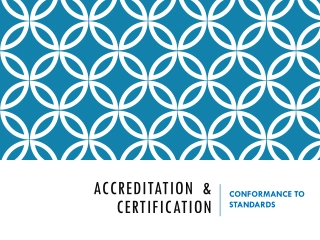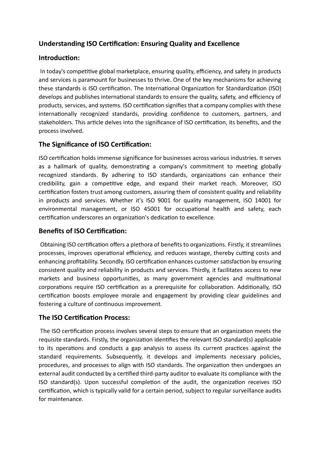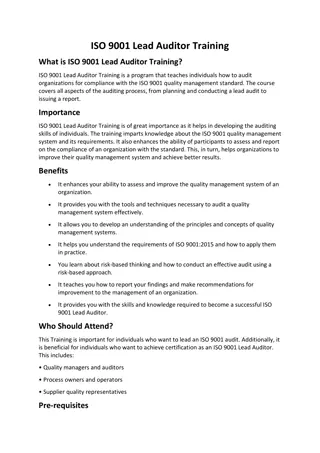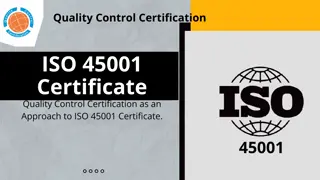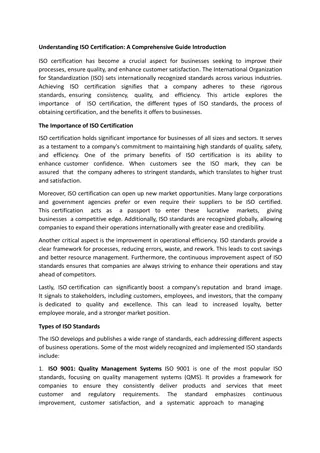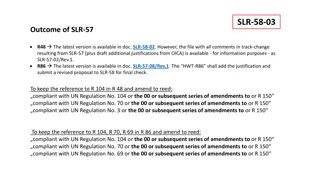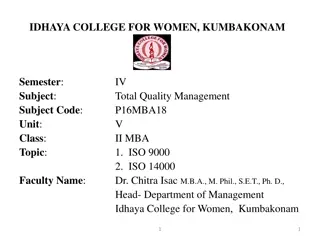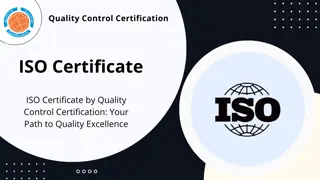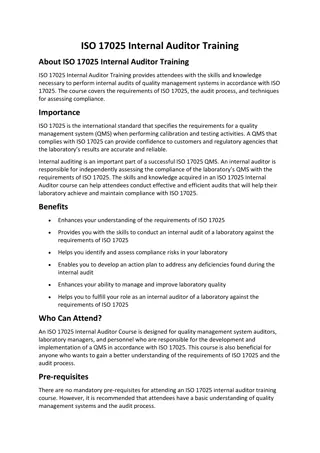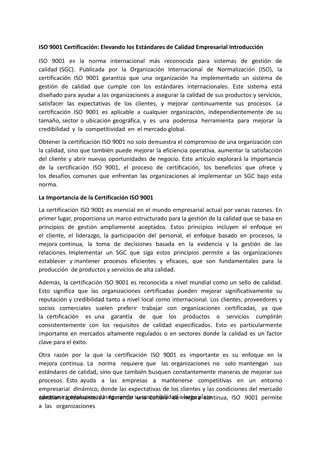Benefits and Potential Problems of ISO 14001 Certification
ISO 14001 certification provides various benefits such as improved efficiency, enhanced quality, risk reduction, and market access. However, there are potential problems including complexity, resource intensity, limited stakeholder engagement, and lack of integration with business processes.
Download Presentation

Please find below an Image/Link to download the presentation.
The content on the website is provided AS IS for your information and personal use only. It may not be sold, licensed, or shared on other websites without obtaining consent from the author.If you encounter any issues during the download, it is possible that the publisher has removed the file from their server.
You are allowed to download the files provided on this website for personal or commercial use, subject to the condition that they are used lawfully. All files are the property of their respective owners.
The content on the website is provided AS IS for your information and personal use only. It may not be sold, licensed, or shared on other websites without obtaining consent from the author.
E N D
Presentation Transcript
ISO14001 ISO14001
IS014001 Process standard in the sustainability standard The establishment of a set of rules governing how people in an organization are supposed to complete a given task or sequences of task. This Photo by Unknown author is licensed under CC BY-SA.
Benefits Improved Efficiency: providing guidelines and best practices for managing processes effectively. Enhanced Quality: Ensuring the product or services consistently meet customer requirements& regulatory standards. Risk reduction: It helps organizations identify and mitigate risks associated with their operations. Market Access& Competitive Advantage: Enhance an organization's credibility and marketability. Stakeholder Confidence and Trust: Build trust and confidence among stakeholders, including customers, investors, employees and regulators.
Potential problems Complexity& Resource Intensity: Particular for smaller organization & limited environmental expertise. Process of development requires time& financial resources. Limited Stakeholder Engagement: Result in lack of input from key stakeholders Lack of Integration with Business Processes Emphasis on Documentation over performance: such as developing policies, procedures, and records.
ISO14100 and Signalling Theory
1. Credibility The certification enhances an organization's credibility by providing an internationally recognized framework for environmental management. By voluntarily adhering to ISO 14001 standards and undergoing certification by accredited third-party auditors, organizations signal to stakeholders that they are committed to environmental responsibility. The certification is bolstered by its rigorous requirements and the involvement of independent certifying bodies, which helps to mitigate concerns about greenwashing or superficial environmental claims.
2. Verifiability The certification emphasizes the importance of documentation, record-keeping, and performance monitoring, which facilitate the verifiability of an organization's environmental management practices. Through the establishment of measurable objectives, regular internal audits, and external certification audits, ISO 14001 enables stakeholders to verify that an organization's environmental performance aligns with its stated commitments. The systematic approach to environmental management prescribed by ISO 14001 ensures that environmental data and information are transparent, auditable, and reliable.
3. Understandability The certification promotes the use of clear and transparent communication regarding an organization's environmental policies, objectives, and performance. The certification encourages organizations to communicate their environmental efforts in a manner that is easily understandable to various stakeholders by requiring the development of an environmental policy, communication channels, and stakeholder engagement processes. The certification supports the use of eco-labelling and sustainability reporting to provide stakeholders with accessible information about an organization's environmental performance.
4. Imitability The certification serves as a model for other organizations seeking to improve their environmental performance and demonstrate their commitment to sustainability. By showcasing the benefits of ISO 14001 implementation, such as cost savings, regulatory compliance, risk reduction, and enhanced reputation, organizations that are certified under ISO 14001 encourage imitation by competitors and peers. The widespread adoption of ISO 14001 across industries contributes to the diffusion of environmental best practices and the advancement of sustainable development goals.
Case study : Case study : Toyota's ISO 14001 Implementation Toyota Motor Company Global automobile manufacturer enhance environmental performance and sustainability across their manufacturing facilities worldwide.
Toyota's ISO 14001 Implementation Process 1) Initial Assessment Toyota assessed their operations, identifying energy consumption, waste generation, water usage, and emissions as significant environmental aspects. 2). Objectives and Targets: Toyota set goals to reduce energy consumption by 10%, achieve zero waste to landfill, and optimize water usage 3). Implementation of Controls: Toyota invested in energy-efficient technologies, implemented waste segregation and recycling programs, and optimized water management systems.
Toyota's ISO 14001 Implementation Process 4.)Monitoring and Measurement: established tracking system for energy, waste, water, and emissions. 5) Continuous Improvement: Toyota analyzed data, implemented corrective actions, and shared best practices across their global facilities. 6). Certification and Recognition: showcasing their commitment to environmental management. They received industry recognition and awards for their efforts.


